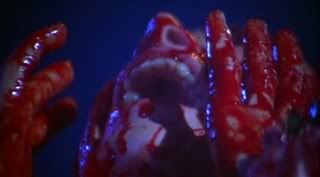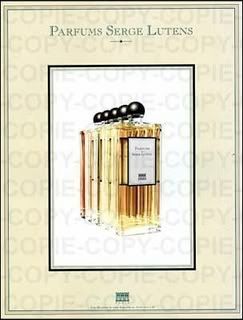Sables flies under the radar amidst the masculine selection chez Annick Goutal, despite the fact that Harrison Ford is supposedly an ardent fan. I guess he's considered "old man" by now and not as hip for a celebrity endorsement. But Sables shouldn't suffer from malrecognition; this is an especially brilliant composition and a unique one at the time of its launch, in 1985. The burnt sugar aspect of helichrysum ~known also as immortelle or everlasting flower~ with its shades of curry, maple syrup and fenugreek aromata make this fragrance one of the most distinctive not only in the Goutal canon, but in general. The onle fragrance more daringly infused with this spicy-caramelic note is Eau Noire in the private line of Dior colognes, composed by Francis Kurkdjian (A scent for which designer Karl Lagerfeld is crazy about!). Asmar by So Oud (launched in 2010) is closer to Sables, although not exactly the same.
Immortelle is an aquired taste for sure. Not everyone feels comfortable smelling like Indian food and helichrysum italicum is called "the curry plant" by some. Still, the initially spicy fenugreek nuances (somewhat mentholated and bitter inky, like in good old Fernet-Branca digestif) in Goutal's Sables are mollified towards the caramelised smoky spectrum; a whiff of pyrazines and malt, for those who appreciate Jeux de Peau by Serge Lutens for instance. The curry note is joined by its conspirator in crime: cumin, with its perceived sweaty aspect, and by a little pepper. Yet one cannot exactly categorise Sables as "dirty", "skanky" or spicy, but rather as smoky sweet and cozy in either winter or summer. In my own personal experience, Sables is a child of the sun and the warmth, and performs best in minute amounts put on the belly or behind the knees in the heat.
Contrary to the standard perception of Goutal scents being ethereal and fleeting, this one is particularly projecting, leaving a memorable trail and lasts very long, so beware of overdosing. It's definitely not intended to be used solely a masculine, although the saltier quota of male skin brings out the herbal and more ambery facets to the fore (much like in Ambre Sultan), while it's sweeter on women. The longer the fragrance stays on warm skin, the more it manifests those burnt sugar notes allied with milky, woody facets of sandalwood without ever becoming cloying. On the whole, Sables's kinship is more with a Lutensian oriental oeuvre, or a more powerful version of Cuir Béluga by Guerlain, than with the Indian dish intensity of Dior's Eau Noire where immortelle contrasts with the medicinal-caramelic ends of spectrum of natural lavender essence projecting a more rustic, rugged edge.
Sables saw the light of day after a journey in Corsica, imbued with the warm and spicy scent of wild immortelle. This fragrance is dedicated to men and women whose originality and subtlety make them just as they are–-that is, authentic. Annick Goutal created it especially for her husband, Alain, who played the violoncello, as a memento from a trip to the so-called Island of Beauty, where the scent of immortelle-sprinkled sand dunes had captured her mind.
To me Sables will always stand as the olfactory equivalent of a particular beach in Lesbos Island in Greece. It is a volcanic place, all hot springs and absolutely no fish in the water, a deserted sugar-like fine sandy beach near a fossiled forest. The warmth of the sun schorches the tree trunks laying in the background. A moment of eternity has just been mine and I can see the history of the earth in a long gaze...
Related reading on Perfume Shrine: Annick Goutal news & reviews, Immortelle: perfumery material, Pyrazines; maple & caramel notes, interview with perfumer Isabelle Doyen
helichrysum flowers pic via stopthatcat
Showing posts with label sables. Show all posts
Showing posts with label sables. Show all posts
Thursday, July 7, 2011
Monday, October 29, 2007
Chypre Rouge by Serge Lutens: fragrance review

Chypre Rouge came into the public scene with one of the most impressive yet somehow incoherent press releases to date.
It ran like this:
“I remember looking at the forest ground, covered with dead leaves, and finding it both macabre and beautiful. Something caught my attention: a strange patch of moss at the base of a tree, it looked as if it were bleeding, purple and red. Ceremonial dress, splendid and dying, lit by the rays of a nearby clearing. “Don’t deny, you will confess!” In this doorless dungeon we look for an exit. Thin light comes from a murdering hole.(press release courtesy of Scenteur d'Ailleurs)
Eagle nest, precious stones, coat of arms, standards, what are we made of? Eternity, limpidity, freshness, beauty, velvet softness. A secret continent of which we would be the body, in golden darkness, moss of spices and vermeil. The kiss of a choirboy on the ring of an archbishop.
Softness and depth, secret in scents where, laying our cheeks we can only dream.”
Now, before you get any naughty ideas about the choirboy and the archibishop's ring, I have to add that imaginative imagery has always been at the core of the Lutens canon, so we are to take this as a flight of fancy, a reminiscence about his childhood in Hansel and Gretel land.
And just where is this mythical land? Osmoz says a propos de Chypre Rouge that it "was inspired by Serge Lutens’s memories of fall in his native Vendée region of western France". Native? Please allow me to disagree on that score. Lutens was born in Lille which is quite far from Vendée. In fact as revealed here, he spent his youth in Lille too!
However I am perfectly willing to believe that he had some extended family or friends who stayed there and that his visits were coloured with the sweeping brush of vermeil and purple mentioned.
It is not without importance to note that he was a neglected child whose mother donned black on her second wedding day, perhaps a symbol that rang poignant in his id. The confessional tone, mingled with the religious overtones of the papal purple, hint at a desire to express some secret ache that needs to surface through the catharsis of the artistic. And so Chypre Rouge becomes deeply personal, psychological endoscopisis rendering it difficult to interpret by someone outside the circle.

The progression to fenugreek and immortelle (the note that accounts for the maple surupy hot sands of a deserted beach of Annick Goutal's Sables and the pronounced curriness in Dior Eau Noire) comes after some minutes to soothe sensibilities and transport into the territory of the spicy with subtle whiffs of flowers, dried, rolled into heaps of curried dust. Mace and coriander raise their beady heads out of this basket that recalls Arabic souks, like most of the Lutens creations, especially Arabie, influenced by his mysterious seraglioat Morocco that no one has ever visited. Named "Al Medina al Hamra", Red City because of its architecture, Marrakesh has served as a rich pool of inspiration for Lutens and his vision of perfume as a homage to a cross-reference of civilisations.
The final phase of caramelised nuts rolled into musky, smooth moss is the least challengening, but by then potential audiences will have either walked away or braved the initial coup in anticipation of the soft nucleus. It is unfortunate that I tend to the former group.
Chypre Rouge launched in 2006 as an Eau de Parfum Haute Concetration, a term that denotes higher concentration of aromatic essences because of the nature of the latter that demand a higher saturation point to be perceptible and is not meant to imply that it is louder in odour volume.
Official notes:
thyme, pine needles, pecans, fruit gums, honey, beeswax, jasmine, patchouli, amber, vanilla, moss and musks.
Instead of further commentary I direct you to Placebo with brilliant Brian Molko and their song "Meds":
(uploaded by dagonsio)
Please remind me to post "The Bitter End" (again by Placebo) if Serge Lutens trully retires from fragrance creation, per rumours.

Top pic from the film Carrie by Brian de Palma (1976)/Filmhai. Ad pic courtesy of autourdeserge.
Subscribe to:
Comments (Atom)
This Month's Popular Posts on Perfume Shrine
-
Among perfume lovers' circles there are no other two words more despised than "old lady" perfume. Is it because often the peop...
-
Iris Nobile by the Italian brand Acqua di Parma (makers of the famous Colonia and the Colonia Assoluta) is celebrating with a special editio...
-
Tauer Perfumes need no introduction: Probably the most successful internet-stemming indie fragrance phenomenon which built sufficient word o...
-
O Marvel! a garden amidst the flames. My heart has become capable of every form: it is a pasture for gazelles and a convent for Christian mo...
-
How many times have you heard that line in one variation or another? Or are you one of the sufferers who feels like you're going to erup...
-
First things first and if you think you have a lucky bone in your body, do drop a comment regarding the Advent Calendar that Tauer Perfumes ...
.jpg)


.jpg)



